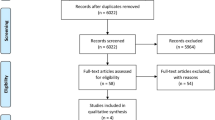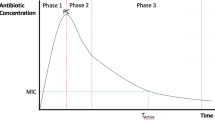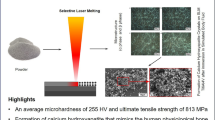Abstract
Purpose
The purpose of this study was to clarify the biomechanical characteristics of cement–material interfaces for the zirconia ceramic and cobalt–chromium (Co–Cr) alloy femoral components used for total knee arthroplasty.
Methods
In the first sub-study, we compared the strength of adhesion of the cement to flat plates, by tensile testing under dry and moistened conditions. In the second sub-study, we compared the maximum load of the cement–component complex by tensile testing. In the third sub-study, we compared the fatigue characteristics of the cement–component complex by use of a dynamic tensile testing machine.
Results
Under dry conditions, the maximum strength of adhesion to the zirconia ceramic plate was the same as that to the Co–Cr alloy plate. Under moistened conditions, however, the strength of adhesion to the zirconia ceramic plate was significantly lower (p = 0.0017) whereas the strength of adhesion to the Co–Cr alloy plate was not reduced. Maximum load for the cement–component complexes for zirconia ceramic and Co–Cr alloy was no different under both dry and moistened conditions. Fatigue testing showed that cement–zirconia adhesion was stronger than cement–Co–Cr alloy adhesion (p = 0.0161).
Conclusions
The strength of adhesion of cement to zirconia ceramic is substantially weaker under wet conditions than under dry conditions. The mechanical properties of cement–zirconia ceramic component complexes and cement–Co–Cr alloy component complexes are equivalent.







Similar content being viewed by others
References
Christel PS. Biocompatibility of surgical-grade dense polycrystalline alumina. Clin Orthop Relat Res. 1992;282:10–8.
Oonishi H, Aono M, Murata N, Kushitani S. Alumina versus polyethylene in total knee arthroplasty. Clin Orthop Relat Res. 1992;282:95–104.
Semlitsch M, Lehmann M, Weber H, Doerre E, Willert HG. New prospects for a prolonged functional life-span of artificial hip joint by using the material combination polyethylene/aluminum oxide ceramic/metal. J Biomed Mater Res. 1977;11:537–52.
Yasuda K, Miyagi N, Kaneda K. Low friction total knee arthroplasty with the alumina ceramic condylar prosthesis. Bull Hosp Jt Dis. 1993;53:15–21.
Dorlot JM. Long-term effects of alumina components in total hip prostheses. Clin Orthop Relat Res. 1992;282:47–52.
Mittelmeier H, Heisel J. Sixteen-years’ experience with ceramic hip prostheses. Clin Orthop Relat Res. 1992;282:64–72.
Nizard RS, Sedel L, Christel P, Meunier A, Soudry M, Witvoet J. Ten-year survivorship of cemented ceramic-ceramic total hip prosthesis. Clin Orthop Relat Res. 1992;282:53–63.
Winter M, Griss P, Scheller G, Moser T. Ten- to 14-year results of a ceramic hip prosthesis. Clin Orthop Relat Res. 1992;282:73–80.
Akagi M, Nakamura T, Matsusue Y, Ueo T, Nishijyo K, Ohnishi E. The bisurface total knee replacement: a unique design for flexion. Four-to-nine-year follow-up study. J Bone Jt Surg Am. 2000;82:1626–33.
Bal BS, Greenberg DD, Buhrmester L, Aleto TJ. Primary TKA with a zirconia ceramic femoral component. J Knee Surg. 2006;19:89–93.
Majima T, Yasuda K, Tago H, Aoki Y, Minami A. Clinical results of posterior cruciate ligament retaining TKA with alumina ceramic condular prosthesis: comparison to Co–Cr alloy prosthesis. Knee Surg Sports Traumatol Arthrosc. 2008;16:152–6.
Yasuda K, Onodera S, Kondo E, Kitamura N, Inoue M. Total knee arthroplasty with cruciate-retention type alumina ceramic condylar prosthesis. Techn Knee Surg. 2007;6:213–9.
Kamishima T, Kitamura N, Amemiya M, Ishizaka K, Kato F, Yasuda K, Shirato H, Terae S. Experimental MR imaging of zirconia ceramic joint implants at 1.5 and 3 T. Clin Radiol. 2010;65:387–90.
Kasahara T, Iwasaki K, Kawamoto M, Watanabe K, Kobayashi D. A case of loosening of KU type after total knee arthroplasty. Chubu-seisaishi. 2005;48:647–8.
Han HS, Kang SB, Yoon KS. High incidence of loosening of the femoral component in legacy posterior stabilised-flex total knee replacement. J Bone Joint Surg Br. 2007;89:1457–61.
Agathopoulos S, Nikolopoulos P. Wettability and interfacial interactions in bioceramic-body-liquid systems. J Biomed Mater Res. 1995;29:421–9.
Davidson JA. Characteristics of metal and ceramic total hip bearing surfaces and their effect on long-term ultra high molecular weight polyethylene wear. Clin Orthop Relat Res. 1993;294:361–78.
Rahaman MN, Yao A. Ceramics for prosthetic hip and knee joint replacement. J Am Ceram Soc. 2007;90:1965–88.
Crookshank M, Coquim J, Olsen M, Schemitsch EH, Bougherara H, Zdero R. Biomechanical measurements of axial crush injury to the distal condyles of human and synthetic femurs. Proc Inst Mech Eng H. 2012;226:320–9.
Vicente A, Toledano M, Bravo LA, Romeo A, de la Higuera B, Osorio R. Effect of water contamination on the shear bond strength of five orthodontic adhesives. Med Oral Patol Oral Cir Bucal. 2010;15:e820–6.
Cacciafesta V, Jost-Brinkmann PG, Süssenberger U, Miethke RR. Effects of saliva and water contamination on the enamel shear bond strength of a light-cured glass ionomer cement. Am J Orthod Dentofacial Orthop. 1998;113:402–7.
Conflict of interest
We declare that no financial support was received for this study and no conflicts of interest exist.
Author information
Authors and Affiliations
Corresponding author
About this article
Cite this article
Kumahashi, N., Uchio, Y., Kitamura, N. et al. Biomechanical comparison of the strength of adhesion of polymethylmethacrylate cement to zirconia ceramic and cobalt–chromium alloy components in a total knee arthroplasty. J Orthop Sci 19, 940–947 (2014). https://doi.org/10.1007/s00776-014-0639-7
Received:
Accepted:
Published:
Issue Date:
DOI: https://doi.org/10.1007/s00776-014-0639-7




